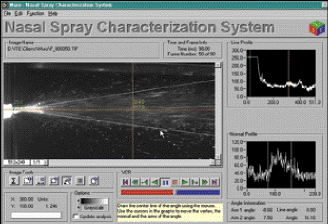Daniel C. McCarthy, News Editor
The US Food and Drug Administration (FDA) requires manufacturers of nasal sprays to demonstrate not only the effectiveness of their product in easing congestion, but also the consistency and uniformity of the ejected pattern of mist. In analyzing these sprays to meet the FDA standards, Muro Pharmaceutical Inc. is using a laser-based, high-speed imaging system developed by Image Therm Engineering Inc.

Muro Pharmaceutical Inc. is combining laser energy, high-speed photography and imaging software for real-time analysis of how its medicated nasal sprays disperse. Courtesy of Image Therm Engineering Inc.
Muro had previously relied on an analytical method used by spray bottle manufacturers, said Frank Bales, manager of research and development. The company impinged the sprays onto thin-layer chromatography plates and extrapolated data about the flying particles from the patterns formed on the plates. Unlike spray bottle manufacturers who use only water in these experiments, Muro needed to examine compounds with a variety of molecular complexities and viscosities.
Muro wanted a system that could perform real-time analysis of the spray's pattern as well as assess the cross-sectional uniformity of its particles. "We knew a system like this wasn't available off the shelf so we would have to develop it," said Bales.
Component selection
Muro's search for a developer led to Image Therm Engineering, which assembled and programmed the system from an electropneumatic spray pump and three photonic components: a continuous-wave diode laser from Lasiris Inc., a MotionCorder SR-500 high-speed camera from Eastman Kodak Co., and LabView/Imaq Vision imaging software from National Instruments.
Dino Farina, a project manager at Image Therm Engineering, would have liked a laser with a lower wavelength to which the camera would be more sensitive, but he said Lasiris' 810-nm laser is the lowest wavelength he could find that operates at 4 W.
"We needed high energy because the particles are not big, they're under high magnification, and they're moving fast through a thin sheet of light," Farina explained. "We opted for the Lasiris diode laser because it was more cost-effective, directly produced a light sheet, provided more than adequate performance, and was easier to use and set up than a YAG or an argon-ion laser."
The system works by shining the laser sheet through a specified axial cross section of the spray and capturing it on camera at 500 frames per second. The imaging software combines the acquired time lapse set of images to create a composite image, which is used for analysis of the geometrical properties of the spray, including divergence angle and flow uniformity. This approach gives the Muro scientists a much better feel for the fluid dynamics of the spray pattern, both visually and quantitatively, Farina said.